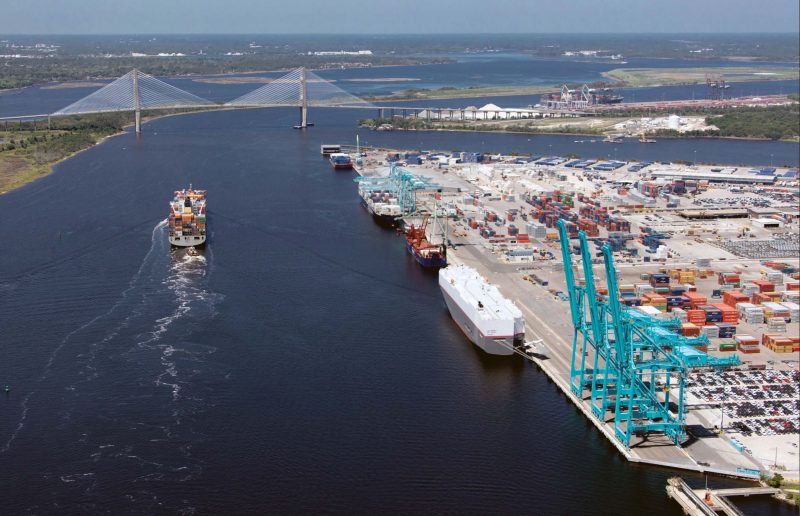
 Jacksonville is a natural seaport and city that sprawls over a huge 840 square miles, making it the largest city and port area in the United States and the most populous in Florida. It spreads out along three meandering rivers and includes a wide entrance from the Atlantic and the Intra Coastal Waterway, a feature running along almost the entire length of Florida. The city has three bridges over the St. Johns River, the Fuller Warren Bridge, the Acosta Bridge and the Main Street Bridge, with the Hart Bridge and cantilever Mathews Bridge, opened on 15th April 1953, crossing just downstream of the city, and the cable stayed Dames Point Bridge opened in 1989 also crossing the river half way to the sea. Jacksonville is some seventeen miles distant from the sea due west, twenty one miles by the winding river.
Jacksonville is a natural seaport and city that sprawls over a huge 840 square miles, making it the largest city and port area in the United States and the most populous in Florida. It spreads out along three meandering rivers and includes a wide entrance from the Atlantic and the Intra Coastal Waterway, a feature running along almost the entire length of Florida. The city has three bridges over the St. Johns River, the Fuller Warren Bridge, the Acosta Bridge and the Main Street Bridge, with the Hart Bridge and cantilever Mathews Bridge, opened on 15th April 1953, crossing just downstream of the city, and the cable stayed Dames Point Bridge opened in 1989 also crossing the river half way to the sea. Jacksonville is some seventeen miles distant from the sea due west, twenty one miles by the winding river.

Jacksonville Port Authority (JAXPORT) is a modern port governed by a Board of Directors, and it owns and operates three container and cargo terminals and one cruise terminal, with annual traffic at around 8.5 million tonnes. Mitsui OSK, Hanjin, NYK and forty other container ship lines, together with Carnival Cruise Lines and Royal Caribbean International cruise ships, are to be seen in the port. The local residents call their city simply ‘JAX’ and it is prosperous with heavy industry including the largest brewery in the world, paper mills and big naval bases. The Port of Fernandina Beach is forty kilometres to the north of Jacksonville with its entrance channel from the Atlantic forming the Georgia and Florida State border.
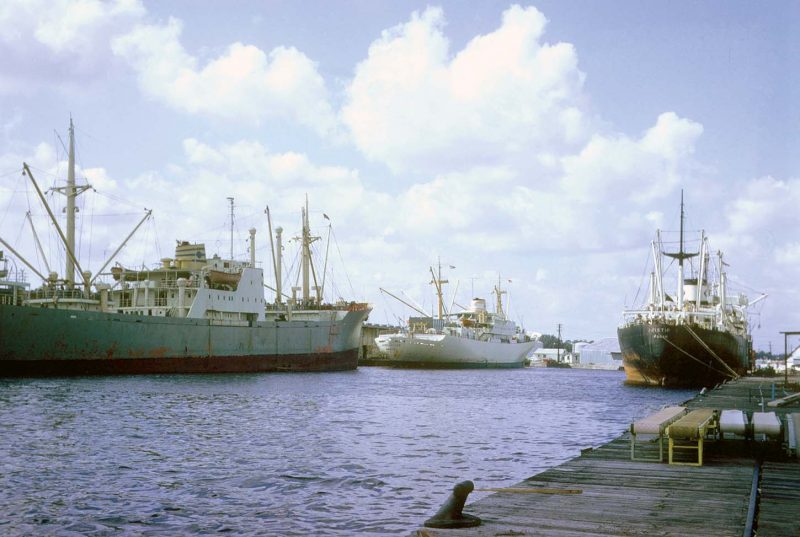
History Of Jacksonville
The Timucua tribe created the first permanent settlement in the Jacksonville area more than six thousand years ago. The first white European settler was French Huguenot (Protestant) explorer Jean Ribault in the mid 16th century, establishing Fort Caroline in 1564 with two hundred settlers. Spanish conquistador Pedro Menendez de Aviles destroyed the fort a year later, killing all the French soldiers except Catholics. The fort was ceded by the Spanish to the British in 1763 but they returned it to Spain twenty years later. The United States of America acquired Florida in 1822, and a year later the nearby town was named Jacksonville after President Andrew Jackson (1767-1845), the seventh American President between 1829 and 1837, and the first Governor of Florida.
Andrew Jackson was born at Waxhaw (South Carolina) and settled in Tennessee and represented the slave holding South. He owned over one hundred slaves to work his cotton plantation, The Hermitage, at Nashville. He traded slaves to other plantation owners and became Commander of the Tennessee Militia, leading campaigns against the Native Indian Creek (Muscogee) tribes of Georgia, Alabama, Louisiana and Florida. He was known as ‘Old Hickory’ to his troops and was ruthless in the slaughter of Native Indians, particularly the Creek Indians. The Creek War (1813-1814) began as a civil war within the Muscogee nation, but General Andrew Jackson used it as an excuse to wage war with his five thousand regular troops. He defeated the Creek Native Indians at the Battle of Horseshoe Bend on 27th March 1814. He became a national hero when he defeated the British at the Battle of New Orleans on 8th January 1815 in the last British campaign in North America.
He then fought the Seminole Indians between November 1817 and July 1818, and was even more ruthless in the annexation of their lands, even taking the land of those tribes that had fought on his side. At this point, he had taken all of the native Indian land of Georgia, three quarters of their land in Florida and Alabama, and one fifth of their land in Louisiana and Mississippi. He took Pensacola in Western Florida in May 1818 from the Spanish, and then most of Western Florida. He was then ordered into Eastern Florida to pursue the Seminole Indians and also took several Spanish forts and deposed the Spanish Governor of Florida. This culminated in his effective annexation of Florida from Spanish control, and he became Military Governor of Florida Territory in 1821. The Indian Removal policy of General Jackson to a line west of the Mississippi had been completed by 1830/32, in the first years of his Presidency, but the remaining Seminole tribes in Florida fought on, with the annihilation of a troop of one hundred U.S. soldiers in December 1835. It took much more money and troops to finally quell the Seminoles by 1837, the last year of his Presidency.
The Florida legislature approved the Jacksonville port charter in 1832, but port growth was very slow due to the American Civil War. Jacksonville was an important supply port for the Confederate Navy and Army in their quest to preserve their way of life, but was occupied and burned several times during the war. Union troops landed at Jacksonville and fought the Confederate Army at the Battle of Olustee, the only Civil War battle in Florida, on 20th February 1864. After bitter fighting, the Union troops retreated with heavy casualties to Jacksonville, and two U.S. transports, Maple Leaf and General Hunter, were sunk in the St. Johns river shortly afterwards.
The opening of the Florida East Coast Rail Road by hotel, plantation and rail road magnate Henry Flagler was important, crossing the St. Johns River at its narrowest point at Jacksonville in the 1890s, enabling it to grow as a seaport between the railroad and the sea. The railroad was extended south from the well heeled and elegant resort of West Palm Beach to Miami in 1896 to create Miami as a city. Harbour improvements at Jacksonville encouraged industrial development, but the destructive Great Fire of 1901 led to the reconstruction or repair of 13,000 homes between 1901 and 1912. The first docks of importance were constructed at Talleyrand in 1912 just below the city centre. The main channel was only 15 feet deep in 1895 but dredging costing $1.8 million increased the depth to 24 feet in 1906 with several small private wharves transferring cargo from ship to rail. The main St. Johns River channel has been successively deepened to 30 feet in 1916, 34 feet in 1952, 38 feet in 1978, 41 feet in 2003, and will be dredged to 47 feet in the near future to accommodate the largest vessels in the world.
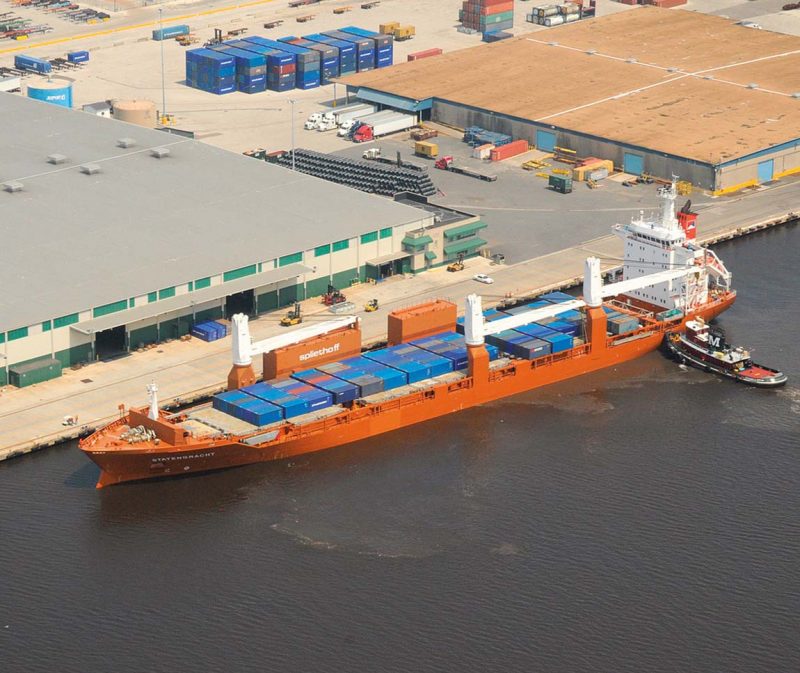
The port became a banking and insurance centre in the twentieth century with three U.S. Navy bases constructed. The Naval Submarine Base at Kings Bay, the Naval Air Station at Jacksonville, and the Mayport Naval Station were constructed shortly before World War II, and became the third largest concentration of the U.S. Navy fleet with berths for 34 ships including aircraft carriers. German U boats operated with great success off the Florida coast during World War II, sinking many ships particularly tankers carrying crude oil from the Caribbean to the northern refineries. German saboteurs entered the Jacksonville port area, but were caught by the big naval presence in the area, with 130,000 naval personnel on the St. Johns River in the Spring of 1942. Jacksonville was the centre of the ‘naval stores’ industry, by that is meant the production of turpentine and rosin, essential for the maintenance of wooden naval ships and their sailing tackle, which were caulked and waterproofed using the rosin. The pine trees of Northern Florida are still chipped today for their gum, which is then distilled into turpentine and rosin.
The St. Johns River Shipbuilding Company was created in Jacksonville during World War II to build wartime ‘Liberty’ ships, completing 82 vessels of this type. The company was established by local shipbuilder and repairer, Merrill-Stevens, with a personal investment of only $400 but with $17 million invested by the United States Maritime Commission. The yard had six building berths spread along the shoreline of the river with inland expansion not practicable, and with the transit of steel and components from the steel working shops parallel to the shore before it reached the head of the ways. The yard began operations in April 1942 with an initial workforce of 258 men, growing to 7,000 in August 1942 and to 20,000 by 1944, and was then closed in August 1945. Yard number 23, Arthur M. Huddell, was completed in December 1943, and is still afloat today in Greece in good condition and named Hellas Liberty. She is one of only three examples still afloat, and she had a long career after conversion to carry flexible pipe for the Pluto undersea pipeline to supply oil fuel to the tanks and vehicles fighting in France in 1944. She then worked as a cable tender for cablelaying vessels for A. T. & T. for forty years until laid up in the James River reserve fleet in 1984, and was towed to Greece in 2008. Yard number 7, Richard Montgomery, was completed in July 1943 but grounded on the Nore Sands in the Medway on 20th August 1944 after being damaged by enemy aircraft. She still has her masts sticking out of the water as it is too dangerous to dismantle her as her holds are full of deadly ammunition.
The Jacksonville Port Authority (JPA) was created in 1963 by a Special Act of the Florida Legislature. The port had 160 acres of docks in the Talleyrand area and had received its first cargo of cars, seven VW Beetles, in 1957. Traffic gradually grew to top five million tonnes in 1992 and 7.5 million tonnes in 1998, with Celebrity Cruises and Carnival Cruise Line announcing plans to begin operations from the port shortly after the Millennium. On 27th February 2004, Carnival Miracle of 2,024 passenger capacity inaugurated the Carnival Cruise Line service with a three day cruise to the Bahamas after the naming ceremony by Jessica Lynch, the vessel having arrived direct from her building yard in Finland. The one millionth cruise passenger passed through the port in 2011 on Carnival Fascination.
Today, Jacksonville is one of the busiest ports in Florida, with big car, truck and vehicle imports and exports, wholesale food distribution, and inter-modal transfer of cargo to the Amtrak, Norfolk Southern, Florida East Coast, and CSX railroads. Jacksonville is the county seat of Duval County located on the ‘First Coast’ region of Florida about 40 kilometres south of the border with Georgia, and 420 kilometres north of the Palm Beaches, and the big ports of Port Everglades and Miami.
Jacksonville Maritime Heritage Centre overlooks the river on the north bank at Jacksons Landing. The museum has a big array of maritime information, scale models, artefacts and shipping logs from the coastal liners that called here in the past. The model of the American aircraft carrier Saratoga of World War II fame is the best of over one dozen ship models. There is a model of the tug Three Friends of 157 grt, launched in 1895 by Broward and Decotts at Jacksonville for the Jacksonville Forwarding Company (A. B. Potter, manager) and powered by a triple expansion steam engine built locally, and later used as a harbour cruise vessel by Florida Governor Napoleon B. Broward. The Maritime Museum is located between the Acosta and Main Street bridges, with the Museum of Science and History in San Marco district, and the Arts Centre at Hogan’s Creek in the Springfield district of the city also worth visiting.
Jacksonville City has been transformed in recent times with an impressive Downtown commercial area with a forest of skyscrapers, the tallest being the Bank of America Tower of 1990, an obelisk that can be seen from miles around. The banks of the St. Johns River make for very pleasant walking along fully pedestrian friendly pathways. However, it has to be remembered when visiting Jacksonville that the port and city cover an enormous area, with public transport or hire car essential to visit the port terminals and points of interest along the St. Johns River to the sea twenty one miles distant.
The Port Of Jacksonville
The port has over 1,800 vessels calling annually including fifty big cruise ships and many large car carriers and container ships. Annual container throughput is 0.7 million TEU or around 3.6 million tonnes, bulk cargo of 2.5 million tonnes, breakbulk cargo of 1.2 million tonnes, general cargo of 1.1 million tonnes, together with around 700,000 cars, trucks and vehicles of all types. The port is located at 30°23′ North, 81°34′ West, and has three main cargo terminals and one cruise terminal as follows:-
Blount Marine Terminal
Located nine miles from the sea on the winding channel, there are 305 hectares of land and 1.6 kilometres of quay located on the north bank of the river half way to the Atlantic and just to the east of Mill Cove. Containers, cars, trucks, vehicles of all types, breakbulk, ro-ro, heavy lift, liquid bulk and general cargo with 22,300 square metres of transit sheds and a container park of 8,400 square metres on this the largest terminal in the port. A heavy lift project cargo berth was rebuilt in eighteen months to open in 2013 with a high weight bearing capacity of 1,800 pounds per square foot. A reinforced heavy lift facility to transfer project cargo to rail has also been opened, unwieldy items up to twenty feet high and thirteen feet wide can be moved in and out of the port by rail.
Talleyrand Marine Terminal
Located just below the city centre, there is 1.5 kilometres of quay with an alongside depth of 11.6 metres currently being dredged to 12.2 metres, and 1.5 hectares of transit sheds with facilities for reefer cargo. Containers, breakbulk, liquid cargo including molasses, vegetable oils, cooking oils, corn syrup, and turpentine, general cargo, cars, trucks, vehicles of all types, steel, paper, timber, reefer cargo, newsprint and speciality papers. Full connection to Amtrak, Norfolk Southern and CSX rail roads. Forestry products e.g. cellulose, pulp, plywood, recycled paper, paper board, coated paper, wood chips and pellets, logs and timber are moved to 950,000 square feet of on-dock warehouse space including covered rail car loading areas designed to protect timber cargoes.
Dames Point Marine Terminal
The newest of the three cargo terminals handling containers, bulk aggregates, breakbulk, and general cargo, and located one mile upstream of Blount Island on the main winding shipping channel on the St. Johns River some ten miles from the sea. The land was acquired in 1998 for 1.5 kilometres of quay with an alongside depth of 12.2 metres at two berths of 365.8 metres for the Hanjin Terminal, and two berths of 350.0 metres for the TraPac International Terminal opened on 12th January 2009 for other container lines. There is also a 41 acre open berth for the discharge of dry bulk cargoes e.g. limestone, road chippings and gravel. The $30 million Jaxport Intermodal Container Transfer Facility (ICTF) opened at Dames Point Marine Terminal on 11th April 2016, and was used immediately to ro-ro load 800 pieces of military cargo including tanks, containers and equipment from rail transporters onto a U.S. Military Sealift vessel.
Jaxport Cruise Terminal
A cruise ship berth of 390.1 metres in length with an alongside depth of 12.5 metres and located near the Dames Point Marine Terminal. The passenger terminal area of 5,800 square metres handles the 2,024 passenger Elation of Carnival Cruise Line offering year round four and five day cruises to the Bahamas. However, this is a temporary berth and will be replaced by a new cruise terminal further down the St. Johns River in due course, as all shipping must currently pass under electric power cables and the Dames Point Bridge with a 175 feet air draft restriction. Carnival Cruise Line, Royal Caribbean International and many other cruise lines are regular callers.
Foreign Trade Zone FTZ64
The three cargo terminals mentioned above have a total of up to 500 acres of free trade zone, with streamlined clearance outside of the jurisdiction of U.S. Customs for certain types of high value cargo, goods and products.

Vessels Using The Port
The fifty lines serving the port include Alianca Lines, American Ro-Ro LLC, APL, ACL, Bahri Auto Carriers and General Cargo Line, BBC Project Cargo, China Shipping, CMA CGM, Crowley American Transport, CSAV, Dockwise, Eukor, Evergreen, Glovis Auto Carriers, Great American Lines, Grieg Star Shipping, Grimaldi, Gulf Africa Line, Hoegh Autoliners, Hyundai, Hapag Lloyd, Hamburg Sud, ‘K’ Line, King Ocean Services, Torvald Klaveness, Liberty Global Logistics, Maersk Line, MSC, MOL, MOL ‘ACE’ auto carriers, NYK, OOCL, Rickmers, Sallaum Line, Seatrade Reefers, Siem Car Carriers, SeaFreight Agencies, Spliethoff, Tote Marine of Puerto Rico, Trailer Bridge Inc., UASC, Wallenius Wilhelmsen Logistics, Yang Ming and Zim Line. Three companies offer auto processing facilities with 250 acres of open storage and 300,000 square feet of car inspection and repair facilities, these are Wallenius Wilhelmsen Logistics, Toyota and Amports. Oil bunkering facilities are available for all vessels with an alongside draft of less than 36 feet, and Moran, McAllister and Crowley Marine tugs can be seen helping big container and cargo ships to turn and berth.
Trailer Bridge Inc. is based at Blount Island and operate ocean going barges between Jaxport and San Juan in Puerto Rico and Santo Domingo de Guzman in the Dominican Republic. The barges carry 213 large containers of 53 feet in length stacked three high with paper, food and agricultural products, and consumer goods. The company was founded in 1991 by the container pioneer, Malcolm P. McLean. Crowley American Transport operates thrice weekly services from Jaxport to San Juan, Aruba, Curacao, La Guaira in Venezuela and Central American ports. They previously also operated the container ships Sea Jaguar, Sea Lynx and Sea Cougar of length 672 feet and built by the Daewoo yard in South Korea in 1998 to six ports in Brazil and Argentina.
Tote Marine has a regular container service to San Juan in Puerto Rico from and to the port, with their container ship El Faro 31,515/73 completed by the Sun Shipbuilding Yard employed on this service in recent years. She sailed from Jacksonville on 1st October 2015 for San Juan but was caught later that day by Hurricane Joaquin near Crooked Island in the Bahamas. She was overwhelmed by the force of the wind and the height of the waves, losing propulsion with a heavy list and unfortunately sank with the loss of her 33 crew members.
Two new LNG powered container ships have since been completed in 2016 at San Diego by the NASSCO yard as Isla Bella and Perla del Caribe for Tote Marine. On 12th January 2016, Isla Bella loaded 100,000 gallons of LNG fuel in a dozen LNG ISO containers while undergoing cargo operations at Jacksonville. The LNG was transferred from the ISO tank containers using a specially developed skid developed in Houston. The transfer skid is designed to allow four ISO tanks to be transferred and emptied at the same time, reducing the transfer time.
Four helicopters worth $15 million each arrived at Jaxport on 26th May 2016 onboard the ro-ro vessel Liberty Pride of U.S. flagged Liberty Global Logistics from the Middle East for refurbishment and upgrades worth $10 million. Three more helicopters and ten ambulances had earlier been shipped from the port on the U.S. flagged Intermarine vessel Ocean Freedom to North Africa. The engines aft SAL Heavy Lift ship Trina of 12,000 dwt and completed in 2008, had earlier unloaded nine oversized speciality tanks weighing 45 tonnes each at Blount Island Marine Terminal into two barges for towing upstream from Jacksonville on the St. Johns River to Palatka (Florida) for use by a paper product manufacturer.
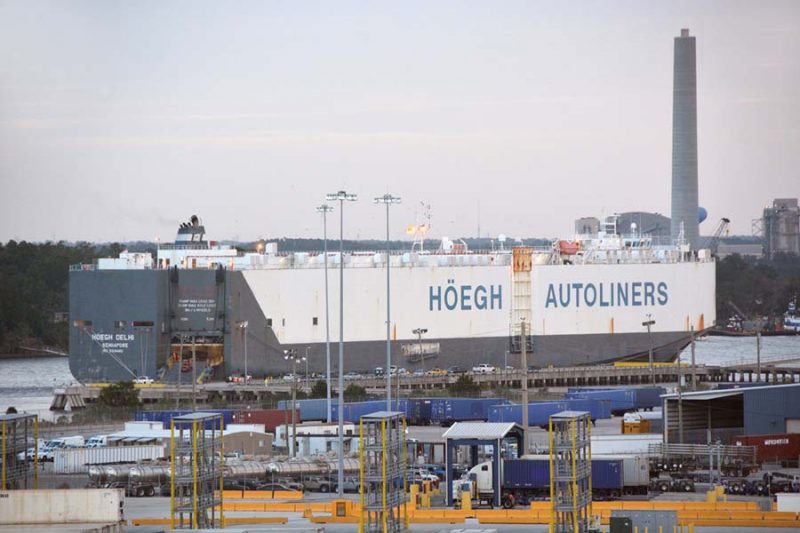
The Cruise Terminal handled the two millionth passenger on 7th July 2016 when a family of three sailed on cruise vessel Elation of Carnival Cruise Line for a four day cruise to the Bahamas. On 11th July 2016, the new NYK car carrier Iris Leader arrived in Jaxport as the first ship to call after passing through the new expanded locks of the Panama Canal. She has dimensions of length 199.0 metres, beam of 34.0 metres, and draft of 8.2 metres, and can carry 1,500 more cars, with a maximum of 8,000 cars, than previous NYK car carriers due to her extra width of five metres. The following day, MOL Majesty of 6,725 TEU capacity became the first container ship to arrive at the TraPac Terminal at Dames Point after passing through the new, expanded locks of the Panama Canal. MOL Majesty is 991 feet in length and requires 46.5 feet of water when fully loaded. The construction phase of deepening the harbour to 47 feet depth was also in full swing by U.S. Federal dredgers. Direct container services are operated from Jaxport to most ports in Asia, Europe, Africa, South America, the Caribbean and other key markets. A trio of new huge gantry cranes arrived in the port in August 2016 to meet this demand, with the heavy lift ship Zhen Hua 14 of ZPM (China) taking almost two months on her long voyage from Shanghai with the cranes.
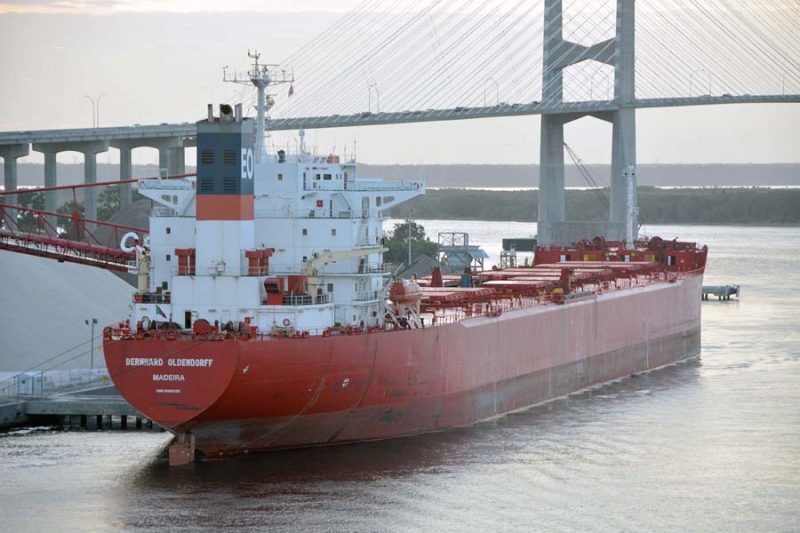
Atlantic Marine Shipyard
This shipyard on Fort George Island is opposite and just upstream of Mayport Naval Station and has been building vessels up to 360 feet in length since 1964. A long list of fishing vessels, tugs, ORSVs, research vessels, ferries and casino ships have included the NASA recovery ship Liberty Star of 484 grt and length 176 feet and completed in 1981 for Space Shuttle Recovery Missions. The 360 feet long casino vessel sisters Majestic Star II and Win Star were completed in 1996/97 for operation in the Great Lakes, with Majestic Star II berthed at Buffington Harbour (Indiana) and Win Star berthed at East Chicago. The passenger ship Cape May Light 4,954/01 was completed for the Delta Queen Steamboat Company of Cape May (NJ). The U.S. Navy oceanographic SWATH research vessel Kilo Moana of 1,500 grt was completed in May 2002 as Yard number 244 for use by the University of Hawaii. She has a service speed of thirteen knots from four diesel electric eight cylinder Caterpillar oil engines of 6,084 bhp driving twin FP propellers.
Six hundred workers were employed in 2005 at the yard, which also repaired ships up to 15,000 grt, with a pier of 640 feet in length and a gantry crane of 90 tonnes capacity and a large dockside transfer system for transferring vessels to a marine railway for repair. Annual turnover for repair work averaged around $40 million, with Caribbean feeder container ships, research vessels, tugs, barges, fishing vessels and deep sea general cargo ships among vessels repaired. The alongside conversion of the former Wilhelm Wilhelmsen ro-ro Tarago of length 754 feet into a Marine Corps pre-positioning ship was completed in 1998 at a contract cost of $76 million.
Jacksonville and the Beaches
Jacksonville Beach is a resort around seventeen miles due east of the city with the gorgeous white sand seen all around the Florida coastline. The sand runs for miles in either direction with the central part at the end of the US-90 route at Beach Boulevard. A pier of length 1,320 metres is located at the north end of the beach, and gives great views over the entire coastline. There are other great beaches in the area e.g. Atlantic Beach, Neptune Beach and Ponte Vedra Beach, with the home of the Sawgrass golf course also here for the PGA Tour and the Players Championships.
The St. Johns River Ferry has been operated by the Port Authority since 2007 using the ferry Jean Ribault for passengers and vehicles on the 1.5 kilometre trip connecting the north and south ends of the Florida State A1A road linking Mayport in the south with Fort George Island to the north and saving a 45 kilometre round journey via bridges. This ferry runs every half hour and takes one over the harbour entrance to the nearby Huguenot Memorial Park on Fort George Island, and the Timucuan tribal nature reserve. The Timucuan Ecological and Historic Preserve encompasses many old plantations, old forts and untouched marshland with a great variety of bird life, predominantly pelicans.
Kingsley Plantation is a reminder of the golden days of the American South between 1763 and 1865. Zephaniah Kingsley made his fortune from cotton, sugar and fruit plantations using African slave labour. Visitors can explore the plantations, barns, kitchens, waterfront loading areas and the emotional slave quarters of this typically southern way of life.
Talbot Islands State Park to the north of the beaches has 1,900 acres of a thickly forested barrier area inhabited by 194 species of birds. There is a four mile hiking trail that winds through this pristine area of oak and magnolia trees, sand dunes and a delightful six mile long beach.
Fort George Island State Park began as a British fort in 1736, and was a vibrant resort in the 1930s decade with the ritzy Ribault Club built in 1928 the scene of lavish beach parties. Fort Caroline National Memorial halfway down the St. Johns River is a memorial to the former French outpost of two hundred settlers established in 1564. This was the first European colony in Florida, and the visitor centre has the reconstructed Huguenot (French Protestant) fort with turf walls.
Port Of Fernandina Beach
This small port is located at the extreme north east point of Florida and is situated on a finger of land thirteen miles long by two miles across known as Amelia Island. The commercial port rubs shoulders with long, unbroken swathes of white and silver sand gracing its eastern edge. This was a haunt of pirates before being transformed into a fashionable Victorian resort area. 30 vessels called at the port during 2015 with the port handling 2,100 TEU of containers and 75,500 tonnes of cargo, mainly 56,100 tonnes of Kraft Liner Board, 8,800 tonnes of oats and 10,600 tonnes of general cargo. Vessels arrive from the Atlantic along the entrance channel that forms the Georgia to Florida State border, and then turn ninety degrees to port at the Fort Clinch State Park to navigate south for 4.5 miles along the Amelia River to the two vessel quay at Fernandina Beach on Amelia Island. Fort Clinch was built in 1847 but had been abandoned by the time of the American Civil War.
The city of Fernandina and Amelia Island have a colourful past, with Fort Tonyn remaining loyal to the British at the start of the American Revolution. During the war, many British soldiers and settlers fled to the area, and by the end of the war there were 16,000 British refugees. In 1783, the British returned Florida to Spain, and the inhabitants of this British colony then embarked on ships for home. Fernandina became a haven for smugglers, pirates and slave traders before the United States of America assumed control of Amelia Island in December 1817 and the remainder of Florida in 1821. Nassau County was established in 1824 with Fernandina as the county seat, with Florida becoming a State in 1845.
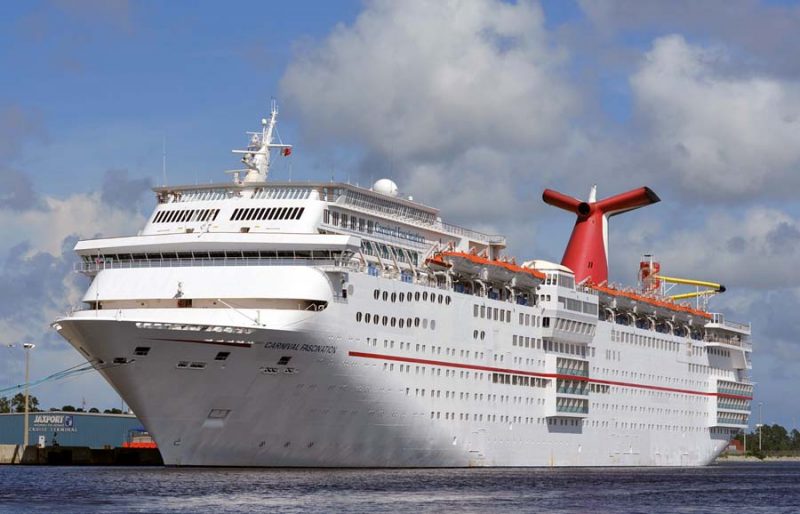
The Port of Fernandina was connected to the Georgia to Florida cross State rail road in the late 1850s, providing rail access to the north and to mid and southern Florida, and also to Cedar Key on the U.S. Gulf. The port became the second busiest American port in the sailing ship era with extensive timber wharves, warehouses, shipping and rail road facilities. The port became a base for shipping military supplies to Cuba during the Spanish American War of 1898, with increased shipments of timber, cotton, naval stores and phosphates. This new prosperity only lasted for a short while before a steady decline set in due to the opening of the main Florida East Coast Railroad by Henry Flagler.
The port is located at 30°41′ North, 81°28′ West with a deep approach channel of 47.0 feet at mean low water, turning south into the Amelia River channel of width 400 feet with a good turning circle. This new deeper Amelia River channel was opened on 5th December 1985, having been constructed by the U.S. Navy, and the new modern quay was financed by the Port Authority by the issue of bonds. There are good inter-modal port connections to the Amtrak, CSX, Norfolk Southern, First Coast Rail Road, and Florida East Coast Rail Road using double stack container and freight trains. The Buccaneer Trail Road Bridge is of modern low height piled construction connecting Amelia Island with Duval County, and replacing an old two lane bridge to the mainland.
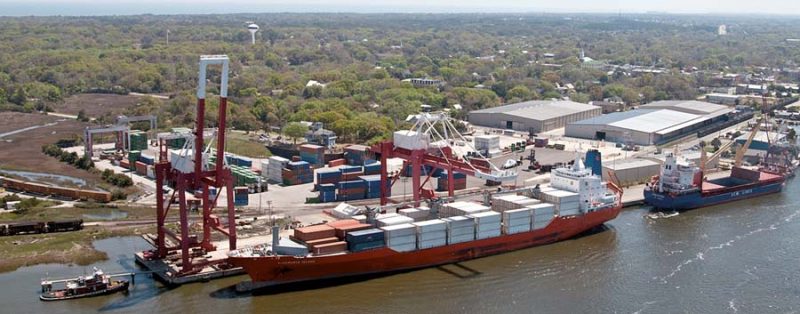
The port is controlled by the Ocean Highway and Port Authority of Nassau County and is operated by Nassau Terminals LLC, a subsidiary of Kinder Morgan on a long term contract with the Port Authority. Nassau Terminals provide stevedore services and terminal handling at a quay of length 1,200 feet served by two gantry cranes capable of an outreach of thirteen containers. There is an alongside depth of 36.0 feet at the quay with only a six feet tidal rise and fall. There are several mobile and rubber tired cranes, three top loaders, forty fork lifts, and a fleet of trailers, flatbeds and trucks. Features of the port are:-
- Two container ships of medium ship or Handymax bulk carriers can be accommodated at the quay, as the port is the only port south of Chesapeake Bay with a deep entrance channel without the need for dredging and free of overhead obstruction.
- Open storage area of 200,000 square feet for a variety of cargoes but mainly forestry products.
- A container freight station of 50,000 square feet with container stuffing, destuffing and stripping and cleaning facilities.
- A forestry products warehouse of 200,000 square feet for use by ten timber and forestry products companies, some close by on Amelia Island.
- Off-port distribution centre of 162,000 square feet.
- Four acre truck, trailer and chassis park.
- Imports of wood pulp, lumber and hardwoods.
- Exports of forestry products, mainly Kraft Liner Board, wood pulp, machinery, treated lumber, steel billets from steel mills in the South East States, rebar and coils.
- Containerised cargo of auto spare parts, wood pulp, steel products, plastics, beverages, frozen food, machinery, consumer goods and building materials.
Postscript
These two Northern Florida ports make substantial contributions to the economies of the States of Florida and Georgia, and complement their big southern Florida cruise and cargo ports of Port Everglades and Miami. The hinterland of both of these Northern Florida ports is far and wide, including Memphis (Tennessee), Charleston (South Carolina), Richmond (Virginia), Mobile (Alabama), Atlanta (Georgia), Tampa (Florida), Orlando (Florida), New Orleans (Louisiana) and Houston (Texas). The port today is still a very important naval base, with the aircraft carriers of the American Sixth Fleet stationed at Mayport, which was the busiest American naval base in 1990 at the start of the Gulf War in Iraq.

Jacksonville is a port with a big future, having experienced year on year growth every year since the Millennium. The deepening of the channel at the Mile Point intersection with the Intra Coastal Waterway will allow all deep draft vessels to enter and leave the port independent of the tide. The port has more warehouse and distribution centre area than the Eastern Seaboard ports of Savannah and Charleston totalled together. Fernandina Beach is a port with an unusual claim to fame. During November to April, vessels take longer than the usual hour to enter the port from taking the pilot to reach their berth as this is the Right Whale calving season in the entrance channel and alterations of course may be needed.
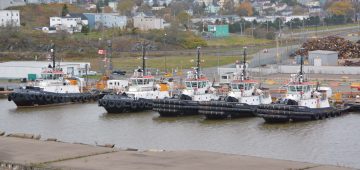



Comments
Sorry, comments are closed for this item